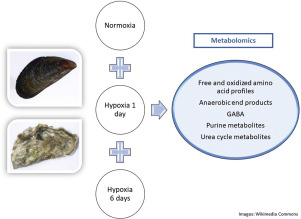当前位置:
X-MOL 学术
›
Comp. Biochem. Physiol. A Mol. Integr. Physiol.
›
论文详情
Our official English website, www.x-mol.net, welcomes your
feedback! (Note: you will need to create a separate account there.)
Effects of hypoxia and reoxygenation on intermediary metabolite homeostasis of marine bivalves Mytilus edulis and Crassostrea gigas.
Comparative Biochemistry and Physiology A: Molecular & Integrative Physiology ( IF 2.1 ) Pub Date : 2020-01-11 , DOI: 10.1016/j.cbpa.2020.110657 Fouzia Haider 1 , Halina I Falfushynska 2 , Stefan Timm 3 , Inna M Sokolova 4
Comparative Biochemistry and Physiology A: Molecular & Integrative Physiology ( IF 2.1 ) Pub Date : 2020-01-11 , DOI: 10.1016/j.cbpa.2020.110657 Fouzia Haider 1 , Halina I Falfushynska 2 , Stefan Timm 3 , Inna M Sokolova 4
Affiliation

|
Marine benthic invertebrates are frequently exposed to fluctuating oxygen levels resulting in hypoxia-reoxygenation (H/R) stress in the intertidal, estuarine and shallow coastal habitats. H/R stress can strongly affect the organisms' physiological performance due to the negative shifts in bioenergetics and redox balance. H/R stress commonly leads to the depletion of energy substrates and accumulation of anaerobic end products, but the effects of H/R stress on the homeostasis of the intermediate nitrogenous compounds are not well understood. We studied the effects of the short-term and long-term hypoxia (1 and 6 days, respectively) and subsequent reoxygenation on the metabolite profiles of free amino acids (FAAs), as well as the intermediates of the urea cycle and purine metabolism in two species of hypoxia-tolerant intertidal bivalves, the blue mussels Mytilus edulis and the Pacific oysters Crassostrea gigas. Accumulation of succinate was assessed to determine the role of anaerobiosis in the metabolic responses to H/R stress. Our study showed that the more hypoxia-tolerant of the two studied species (C. gigas) had lower rate of succinate accumulation during hypoxia (indicating stronger metabolic rate suppression) and was better able to maintain the homeostasis of nitrogenous intermediates during H/R stress compared with the less hypoxia-tolerant M. edulis. Furthermore, analysis of the metabolite profiles indicate that the oysters maintain high levels of cytoprotective compounds (such as taurine and GABA), accumulate lower levels of potential prooxidants (such as succinate and hypoxanthine) and experience less damage to oxidation-prone thiol-containing amino acids such as cysteine, homocysteine and methionine during hypoxia and reoxygenation compared with the blue mussels. This study indicates a potentially important role of intermediate metabolite homeostasis in the tolerance to prolonged hypoxia and H/R stress in marine organisms and opens avenue for further testing of this hypothesis in a broader comparative framework.
中文翻译:

缺氧和复氧对海洋双壳贝类Mytilus edulis和Crassostrea gigas中间代谢产物稳态的影响。
海洋底栖无脊椎动物经常暴露于波动的氧气水平,导致潮间带,河口和浅海沿岸生境产生缺氧-复氧(H / R)压力。由于生物能学和氧化还原平衡的负向变化,H / R应激会严重影响生物体的生理性能。H / R应力通常导致能量底物的消耗和厌氧终产物的积累,但是H / R应力对中间含氮化合物稳态的影响尚不十分清楚。我们研究了短期和长期缺氧(分别为1天和6天)和随后的复氧对游离氨基酸(FAA)代谢产物以及尿素循环和嘌呤代谢中间产物的影响。两种耐缺氧的潮间双壳类,蓝色的贻贝可食用的贻贝和太平洋的牡蛎Crassostrea gigas。评估琥珀酸的积累,以确定厌氧菌在对H / R应激的代谢反应中的作用。我们的研究表明,两个研究物种(C. gigas)的耐缺氧性更高,在低氧条件下琥珀酸盐的积累速率较低(表明较强的代谢速率抑制能力),并且能够更好地在H / R胁迫下保持含氮中间产物的稳态。与耐缺氧性较低的M. edulis比较。此外,对代谢物谱的分析表明,牡蛎保持了高水平的细胞保护性化合物(例如牛磺酸和GABA),与贻贝相比,在低氧和复氧过程中,其潜在的氧化剂(例如琥珀酸盐和次黄嘌呤)的积累水平较低,并且对易氧化的含硫醇的氨基酸(例如半胱氨酸,高半胱氨酸和蛋氨酸)的损害较小。这项研究表明中间代谢物稳态在海洋生物对长期缺氧和H / R胁迫的耐受性中具有潜在的重要作用,并为在更广泛的比较框架中进一步检验该假设开辟了道路。
更新日期:2020-01-13
中文翻译:

缺氧和复氧对海洋双壳贝类Mytilus edulis和Crassostrea gigas中间代谢产物稳态的影响。
海洋底栖无脊椎动物经常暴露于波动的氧气水平,导致潮间带,河口和浅海沿岸生境产生缺氧-复氧(H / R)压力。由于生物能学和氧化还原平衡的负向变化,H / R应激会严重影响生物体的生理性能。H / R应力通常导致能量底物的消耗和厌氧终产物的积累,但是H / R应力对中间含氮化合物稳态的影响尚不十分清楚。我们研究了短期和长期缺氧(分别为1天和6天)和随后的复氧对游离氨基酸(FAA)代谢产物以及尿素循环和嘌呤代谢中间产物的影响。两种耐缺氧的潮间双壳类,蓝色的贻贝可食用的贻贝和太平洋的牡蛎Crassostrea gigas。评估琥珀酸的积累,以确定厌氧菌在对H / R应激的代谢反应中的作用。我们的研究表明,两个研究物种(C. gigas)的耐缺氧性更高,在低氧条件下琥珀酸盐的积累速率较低(表明较强的代谢速率抑制能力),并且能够更好地在H / R胁迫下保持含氮中间产物的稳态。与耐缺氧性较低的M. edulis比较。此外,对代谢物谱的分析表明,牡蛎保持了高水平的细胞保护性化合物(例如牛磺酸和GABA),与贻贝相比,在低氧和复氧过程中,其潜在的氧化剂(例如琥珀酸盐和次黄嘌呤)的积累水平较低,并且对易氧化的含硫醇的氨基酸(例如半胱氨酸,高半胱氨酸和蛋氨酸)的损害较小。这项研究表明中间代谢物稳态在海洋生物对长期缺氧和H / R胁迫的耐受性中具有潜在的重要作用,并为在更广泛的比较框架中进一步检验该假设开辟了道路。











































 京公网安备 11010802027423号
京公网安备 11010802027423号